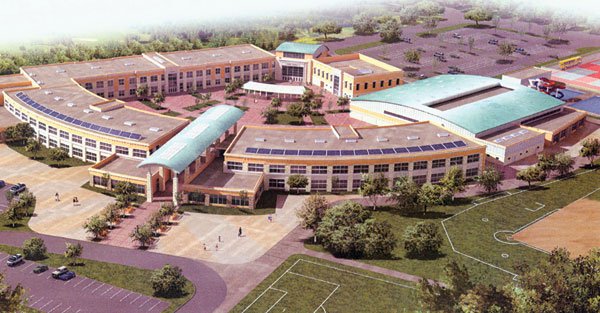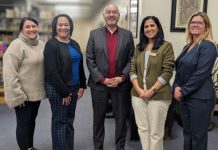Behind closed doors, a panel of 17 teachers, parents and school
officials led by consultant Tom Williams have been drawing
lines
– lines that will divide the community’s students into two
groups – those who attend the new Christopher High School and those
destined for Gilroy High School.
Behind closed doors, a panel of 17 teachers, parents and school officials led by consultant Tom Williams have been drawing lines – lines that will divide the community’s students into two groups – those who attend the new Christopher High School and those destined for Gilroy High School.
It’s a delicate delineation that Superintendent Deborah Flores says will zig and zag its way across the Gilroy map.
“Boundaries can be very controversial,” she said. “Establishing high school boundaries is one of the biggest things a district can do. People are worried that we’ll create a school of the have nots and the haves.”
Socioeconomic status, traffic patterns and population density of Gilroy’s neighborhoods are all factors that influence the decision, committee members said.
Given the new high school’s location in northwest Gilroy and the affluent developments surrounding the plot of land, “it would be easy to create a school with a higher socioeconomic status than GHS,” Flores said. Many members of the community have voiced their concern with this scenario, she said. The committee was aware of this public concern from the start, she said, and made it a priority to concentrate on creating two schools that represent the community from a socioeconomic standpoint. In fact, the committee never even looked at ethnicity as a factor, she said.
“I don’t believe any of us think that would be appropriate to just use ethnicity,” she said. “Socioeconomic status spans all ethnic groups. All strata of the socioeconomic spectrum should be represented at each school.”
When the committee first convened, each member wrote their foremost concerns on a note card, parent Marta Dinsmore said. A resident of Gilroy for 40 years, she wants equality “in all the ways that are important,” with a priority on socioeconomics.
“If you had a rich high school and a poor high school, it divides the community,” Dinsmore said.
As a native Gilroyan, her service on the committee was motivated by her civic duty.
At committee meetings, the group broke up into smaller groups to analyze maps of Gilroy’s neighborhoods and population projections, said Darren Salo, district transportation director. He said that, despite the controversial nature of the decision, committee members “were on the same wavelength, for the most part.”
CHS will open with about 600 ninth and 10th graders and will grow to accommodate 1,100 students by 2012. Once additional classroom space is added, the facility will house 1,800 students. The school’s capacity also influenced the committee’s decision.
After deciding which neighborhoods fulfilled the capacity requirement, the committee reconvened to fine tune the numbers, adjusting for socioeconomic equity. With the help of the demographer, the group looked at the number of kids in each neighborhood and compared their socioeconomic status to that of the district, Ascension Solorsano Middle School Principal Sal Tomasello said.
“There’s not a nice, clean line,” Flores said. “If you draw the line down any main street, the numbers don’t work.”
“We don’t want it to look like a puzzle,” said Gilroy Teachers Association president, Michelle Nelson. She said the committee is working “as best we can” to avoid splitting neighborhoods and sending childhood friends to different schools.
The existing middle school boundary lines reflect this predicament. Large chunks of Gilroy are funneled into each of the three middle schools, with the rural dwellers at Ascension Solorsano, central northerners attending South Valley and central southerners and a large northwestern portion at Brownell.
Thus far, meetings have been closed to the public.
“They want to make sure it’s all finalized before they spill the beans,” Nelson said. The shroud of secrecy results from the chaos that could arise if the group was too big, committee members agreed.
The public will have the opportunity to voice their opinions at two upcoming hearings. After the committee listens to concerns, they will tweak their decision if necessary before presenting their recommendation to the school board.
“What’s important to me is to have two successful schools,” Trustee Javier Aguirre said.
He hopes that those profiles are similar in terms of income levels and parents’ educational background, which are “key factors,” he said. An alumnus of GHS himself, Aguirre experienced a diverse blend of ethnicity, socioeconomic status and backgrounds, he said. That experience readied him for his college career at Stanford University, where again, he encountered students whose backgrounds ran the gamut from first generation college students to professors’ children.
“We live in a very mixed community and that mix of students should be present at both high schools,” he said.
Boundary committee information
Public Hearings
7 p.m. April 15 at Solorsano Middle School
7 p.m. April 16 at South Valley Middle School
Committee members
Deborah Flores: committee chair/superintendent
Juanita Contin: facilitator/consultant
Tom Williams: enrollment projection consultant
Traci Dalke: parent
Marta Dinsmore: parent
Matt Hungerford: GHS staff
Mara Kuwada: GHS staff
Michelle Montez: parent
Michelle Nelson: teachers association president
Rachel Perez: community member
Darren Salo: transportation director
Kermit Schrock: GHS staff
Cathy Shostle: parent
Sal Tomasello: Solorsano principal
Fred Tovar: parent
Maria Zendejas: parent
Ernie Zermeno: community member












